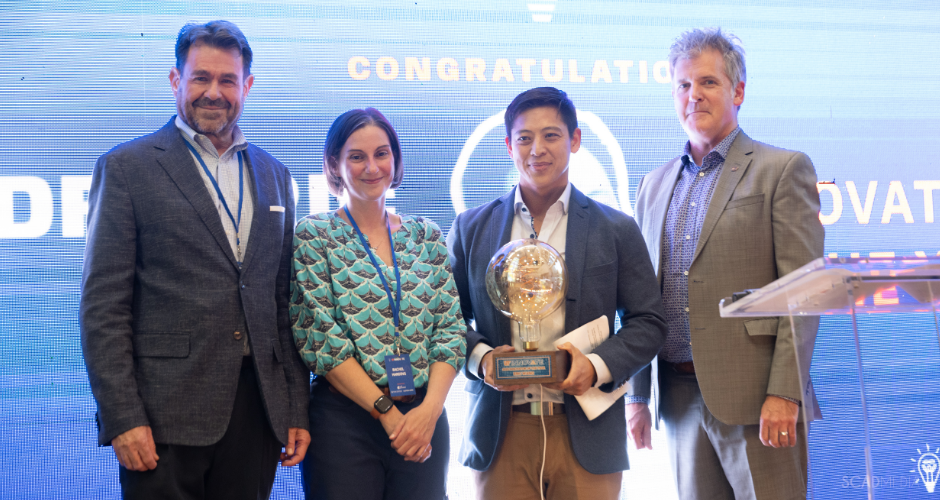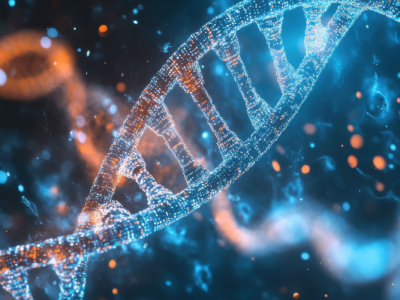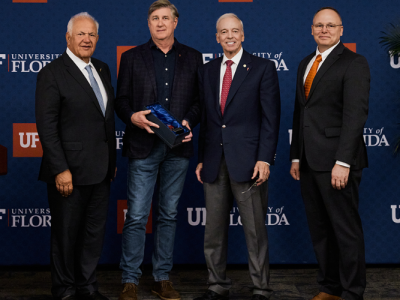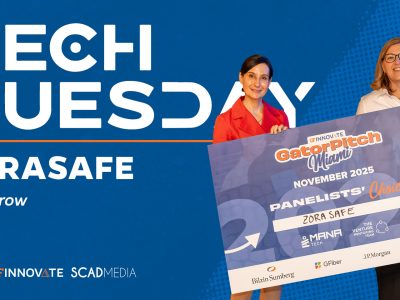Image courtesy of SCAD Media
Standing InnOvation Celebrates 40 Years of Tech Transfer and 30 Years of Biotech Incubation
Gainesville, Fla., October 30, 2025- UF Innovate | Tech Licensing celebrated the achievements of University of Florida innovators at its eighth annual Standing InnOvation event on Wednesday, October 29, recognizing the groundbreaking research discoveries made in fiscal year 2025.
This year’s event also marks 40 years since UF began transferring technologies from the lab into the marketplace and 30 years since it opened its first biotech incubator in Alachua, what is now called UF Innovate | Accelerate at Sid Martin Biotech.
Through UF Innovate, UF has advanced research, empowered entrepreneurs, and driven global impact since 1985. Sid Martin Biotech has played a vital role in UF Innovate’s legacy of innovation, supporting biotech startups and fueling breakthrough discoveries since 1995.
“As excited as we are about the anniversaries, it’s what those 40 years in tech transfer, those 30 years in incubation have produced that counts,” said Jim O’Connell, assistant vice president of commercialization at UF and director of UF Innovate. “That’s 10,000 plus inventions, thousands of patents, licenses, and startups, and roughly one billion dollars annually poured back into state’s economy.”
Standing InnOvation honors UF innovators who disclosed, optioned, licensed, or had a patent issued in the fiscal year, which ended on June 30. This year’s celebration saw the recognition of 796 innovators, all of whom contributed in some way to 435 new technologies disclosed, 130 licenses, 130 issued patents, or the 9 new startup companies. The event is billed as a well-deserved “standing ovation” for excellent work.
The annual celebration kicked off with a high-impact keynote session, From Founder to Funder with Melissa Medina, at Santa Fe College’s Blount Center. Melissa Medina, the co-founder, CEO, and president of eMerge Americas—a global tech conference and expo that launched in 2014—has positioned South Florida as a leading destination for innovation and investment.
A Gator alum, entrepreneur, philanthropist, community leader, and investor, Medina offered Gainesville’s entrepreneurial community insight into her 20+ year journey.
In addition, the InnOvation Showcase, arranged by UF Innovate | Pathways, coincided with the Standing InnOvation networking and awards event. The third annual showcase featured 10 of the 16 University of Florida colleges, showcasing the latest innovations from their researchers.
Eric Wang Named Innovator of the Year
Dr. Eric Wang’s research focuses on all aspects of neuromuscular and neurological diseases, as well as RNA biology. Specifically, his lab in the Department of Molecular Genetics and Microbiology in the College of Medicine focuses on myotonic dystrophy, a disease caused by a genetic mutation, and how the mutation causes problems in muscles, the heart, and the brain.
“My lab is really focused on drawing a more defined path between basic understanding of disease mechanisms and how we’re actually going to treat them,” said Wang, an associate professor.
In addition to being a dedicated scientist, Dr. Wang is also an entrepreneur. He is the co-founder of Kate Therapeutics, a UF biotechnology company that developed AAV-based gene therapies for muscle and heart diseases. In November 2024, Kate Therapeutics was acquired by Novartis for $1.2 billion—UFRF had a significant equity position, resulting in excellent financial returns to the University of Florida.
“Eric Wang isn’t just a researcher doing research to get a grant and another publication. He’s doing things that he really believes… The University of Florida is very fortunate to have [him],” said Dr. Jackson Streeter, director of UF Innovate | Ventures.
When selecting the Innovator of the Year, UF Innovate considers a researcher’s body of work and selects someone who has made significant contributions that have been licensed and taken to the marketplace, sometimes by the researcher launching a startup based on discoveries.
The 2025 Inventions of the Year
For the Inventions of the Year, each of the six licensing teams chooses one technology from their portfolio. Out of the 435 discoveries disclosed in fiscal year 2025, licensing officers selected six that stood out as having great potential.
HIPER-X: Transforming Data Communication Within High-Performance Computing Systems
In the world of high-performance computing, energy efficiency is a major concern. Traditional electrical signals consume a lot of energy, especially in systems used for artificial intelligence and machine learning.
Dr. Volker Sorger, the Walden and Paula Rhines Endowed Professor in Semiconductor Photonics and Deputy Director of Strategic Initiatives at the Florida Semiconductor Institute, and his research team, Dr. Hangbo Yang, a research associate professor, and Shweta Meshram, in the Department of Electrical and Computer Engineering, are addressing this concern head-on with HIPER-X.
HIPER-X, which stands for Heterogeneous In-Package Photonic Engine Platform for Extreme AI, uses light to communicate between processing units, reducing energy consumption and increasing efficiency. The revolutionary platform enhances data communication with high-performance computing systems, such as GPUs and CPUs.
“We want to use photonic communication between them to reduce the energy power,” said Dr. Yang.
According to Yang, if HIPER-X replaces traditional electrical signals, the total energy consumption can be reduced by 80%. This is a significant improvement, especially in high-performance computing systems where energy efficiency is crucial.
The team is working to develop this technology further, with plans to increase the number of processing units that can communicate with each other. They are also collaborating with industry partners to apply HIPER-X to next-generation GPU developments.
“Their technology will result in new and improved communication methods, sensor technologies, and ultimately, quantum computing,” said Dr. Richard Croley, the licensing officer managing this technology.
Genetically Modified Plodia Interpunctella Silk and Uses Thereof
Therapeutic silk fibers: What are they? Why should you care?
Imagine taking an agricultural pest and turning it into a protein factory. One that produces therapeutic proteins, which could be used to treat rare diseases and even cancer.
That’s exactly what Dr. Whitney Stoppel, associate professor and William P. and Tracy Cirioli Term Professor, in the Department of Chemical Engineering, is exploring.
Stoppel and her team, including Paul Shirk, Bryce Shirk, and Lauren Eccles in the Stoppel Lab, are engineering the Indianmeal moth to produce silk fibers containing therapeutic proteins. These silk fibers are natural, biocompatible materials that stabilize and protect therapeutic proteins at room temperature, making therapeutic proteins more accessible to patients around the world.
By genetically modifying the silk fibers to entrap therapeutic proteins, the researchers hope to create a system that eliminates the need for complicated and expensive processes like protein purification systems.
This Invention of the Year has the potential to make a significant impact on the field of medicine and improve the lives of patients around the world. Its development is a testament to the power of interdisciplinary research and collaboration.
“We’re really excited about the potential of this technology and are working to bring it to market as soon as possible,” said Dr. Stoppel.
Integrative Framework for Predicting JAK Mutations and Their Impact on Drug Efficacy
To make informed decisions about treatment, it is important to understand how changes in certain proteins impact the effectiveness of drugs.
Dr. Raquel Dias, an assistant professor in the Department of Microbiology and Cell Science at UF | IFAS, and her team—including Dr. Joseph Larkin III, Jose Ferreira da Silva, Mathew Richardson, and Ayana Price—are using advanced AI to predict how mutations in JAK (Janus Kinase) proteins affect their structure and function.
JAK proteins are crucial for processes like cell growth and immune responses, but mutations can lead to diseases like cancer or make treatments less effective. This technology uses a combination of AI modeling and in silico validation to predict potentially impactful mutations. By integrating AI techniques, this integrative framework provides a comprehensive approach to identifying mutations in JAK2 and characterizing their structural, functional, and clinical implications.
This advanced analysis could help design more effective therapies and keep up with changes found within cancers and other diseases. Ultimately, it leads to not only more impactful treatments but also the ability to personalize such treatments—a major goal of modern medicine.
Topical Formulation Offers New Hope for Treating Diaper Dermatitis in Premature Infants
Diaper dermatitis is a common but serious problem for premature infants, one that often resists standard treatments. Now, a topical formulation developed by Dr. Juan (JC) Roig, from the Department of Pediatrics at the University of Florida College of Medicine, offers a promising new approach to managing this painful and persistent condition.
Premature infants are particularly vulnerable to skin breakdown due to their underdeveloped skin barrier and frequent exposure to moisture and irritants. Combined with frequent bowel movements and a limited ability to tolerate gut challenges, this can result in persistent and severe skin irritation that is difficult to treat and slow to heal.
This UF Health invention provides a protective barrier that helps prevent further damage while delivering antifungal and antibacterial agents to support faster healing. It is designed specifically for use in medically fragile infants, where existing treatments often fall short. This innovation could offer a new standard of care for treating skin conditions in the most vulnerable patients.
New One-Step ELISA Test Speeds Up Medical Diagnoses Without Refrigeration
ELISA, which stands for enzyme-linked immunosorbent assay, is a widely used test that detects specific proteins or substances in samples such as blood or urine. However, traditional ELISA tests are time-consuming and involve multiple complicated steps. They also often require refrigeration of key materials.
Researcher Dr. Gregory Hudalla from the Department of Biomedical Engineering at the University of Florida, along with colleagues Dr. Marcio Resende and Junha Park, developed a new One-Shot ELISA that is faster and easier to use. This diagnostic tool combines the coating protein, blocking agent, and secondary antibody, all of which are typically separate steps in a traditional ELISA, into a single freeze-dried package. This simplifies the process, allowing diagnostic testing to occur almost instantly.
One-Shot ELISA uses freeze-drying, also known as lyophilization, to combine all test components into a single, stable package. This preserves the materials without refrigeration, similar to how freeze-dried foods stay fresh, and enables faster results.
The process also incorporates special stabilizers, including PLGA nanoparticles and phytoglycogen, which protect delicate proteins like antibodies during drying and storage. These lyoprotectants help maintain the test’s stability and reliability by preventing protein damage such as denaturation or aggregation. This innovation not only extends shelf life and simplifies operation but also offers greater flexibility for manufacturers and healthcare providers by eliminating the need for cold chain logistics.
AI-Accelerated Workflow for Superconductor Discovery
Faster. Smarter. Revolutionary.
These three words capture the impact of an invention from Dr. Richard Hennig in the Department of Materials Science and Engineering, Dr. Peter Hirschfeld in the Department of Physics, and their collaborators Jason Gibson and Ajinkya Hire at the University of Florida.
The discovery of superconducting materials, which conduct electricity without resistance, has traditionally been slow and resource heavy. This invention introduces a workflow that applies artificial intelligence to make the discovery process faster and more efficient.
Built around a deep learning system called the Bootstrapped Ensemble of Equivalent Graph Neural Network, or BEE-NET, the model predicts critical temperatures of superconductors using data on crystal structures and phonon density of states. It is trained on different data types, including crystal structure only and coarse phonon density of states, and evaluated with loss functions like mean squared error, weighted mean squared error, and Earth Mover’s Distance to improve accuracy and reliability.
The invention combines BEE-NET with machine learning and physics-based simulations to filter materials from large databases based on formation energy, bandgap, critical temperature, and energy stability. The most promising candidates are then refined using Density Functional Theory simulations. The workflow has identified over 700 potentially stable superconductors. Two of these materials, Be2HfNb2 and Be2Hf2Nb, have been successfully synthesized and confirmed in the lab.
By combining AI and materials science, this invention brings us closer to next-generation superconductors.
InnOvation Showcase
For the third consecutive year, the InnOvation Showcase was a part of Standing InnOvation. The exhibition, curated by UF Innovate | Pathways, featured 10 of the 16 University of Florida colleges. It included the College of Design, Construction and Planning, the College of Medicine, the College of the Arts, and the Herbert Wertheim College of Engineering.
The colleges showcased their latest innovations, ranging from red-light-activated photo initiators to gamification and learning through virtual reality simulations. Guests had the opportunity to visit each kiosk and interact with each invention during the networking reception.
In Conclusion
The Innovator of the Year and the six recipient teams of Invention of the Year received special recognition during the Standing InnOvation program with trophies fitted with Edison lightbulbs.
In addition, Tech Licensing honored all other inventors who hit important milestones during the fiscal year. Special awards were developed for those who disclosed, optioned, or licensed technologies and received an issued patent.
Inventors picked up gift bags with their awards, which included a commemorative pint glass for diclsoing, a coaster for optioning, a license plate for licensing, or a personalized patent mug for each patent issued in the fiscal year.
The Standing InnOvation program was also an opportunity to honor the teams receiving funding through UF Innovate’s Innovation Fund. Three teams received $50,000 and four teams received $25,000 for their projects.
The three $50,000 awardees are:
- Christine Schmidt: Human Peripheral Nerve-Based Injectable Hydrogel for Spinal Cord Regeneration
- Ron Davis and Neelam Shahani: Neuroprotective Compounds for Neurodegenerative Diseases
- Greg Hudalla and Marcio Resende: Phytoglycogen as a Biopharmaceutical Stabilizer
The four $25,000 awardees are:
- Aaron Costin: Wireless Connectivity for Intelligent Construction Jobsites
- J.C. Roig: Medical Device Portfolio for the Benefit and Improvement of Neonatal Care
- Diane Osman: “Toni” Uterine Atony Simulator for Healthcare Professionals
- Amanpreet Kapoor: Edugator: An AI-Enabled Tool for Creating and Delivering Interactive Computing Content
Each team received a large check from Pathways program director Anita Rao.
Written By:
Andrea Dautant, Marketing and Communications Manager
Kaibry Staggs, Social Media Producer







